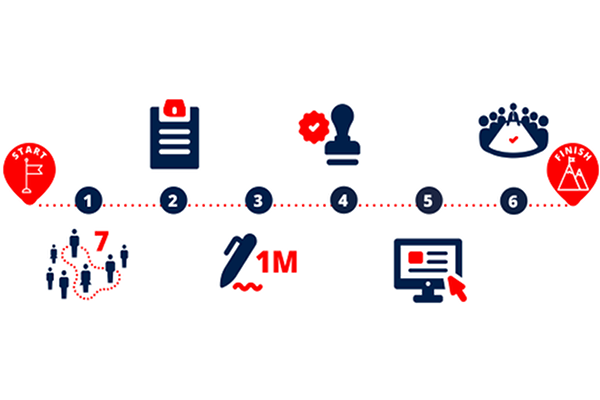
Read how the European citizens' initiative works in this guide:
Step 1: Get started
Before launching an initiative, it is worth considering some of the key practical aspects, including:
- Is asking for EU legislation to be passed the best way to achieve your goals?
- You must first set up a group of organisers composed of at least 7 EU citizens living in 7 different EU countries. To do so, you need to gather people from different EU countries who are willing to support your cause.
- How will you organise your campaign to collect the signatures?
You can find detailed advice on all these points on the European Citizens’ Initiative Forum
Step 2: Get your initiative registered
Before you can start collecting signatures for your initiative, you have to ask the Commission to register it.
For this, you will need to:
- Create an organiser account. You will use this to manage your initiative and liaise with the Commission throughout its lifecycle.
- Provide a description of your initiative in one of the official EU languages (as well as details and relevant documents on the group of organisers, funding received, etc.)
The Commission is not obliged to register all initiatives. It only registers initiatives that meet certain criteria.
Once you ask for your initiative to be registered, the Commission will assess whether or not to accept it.
You will receive an answer within 2 months (or in some cases 4 months).
If the Commission decided to register your initiative, it will be published here.
Step 3: Get support
You need to get the support of at least 1 million EU citizens,
with thresholds (minimum numbers) in at least 7 EU countries.
They must fill in a specific statement of support form.
You can collect:
- on paper (pre-filled forms, downloadable from your organiser account)
- online (using the online collection system).
These forms are available in all EU official languages. Throughout the collection procedure, you have to comply with data protection rules.
Timing
When you are ready to launch your campaign, you must set a kick-off date
(at the latest 6 months from the date your initiative was registered) and inform the Commission at least 10 working days before.
You then have 12 months to collect statements of support.
Who can sign?
To sign, people must be:
- EU citizens (nationals of an EU country)
- old enough to vote in European elections or aged at least 16 in some countries
TIP – It is better to collect more signatures than required. Sometimes the national authorities might not be able to validate all the statements of support you provide.
More on collecting signatures
Step 4: Get statements of support verified
If you manage to collect enough signatures within the 12-month timeframe, group them by nationality and send them for verification to the responsible authorities in each EU country.
You have up to 3 months to do so from the end date of your collection period.
The authorities then have another 3 months to verify how many statements of support are valid (they will issue you with a certificate for this).
TIP – The Commission provides a secure file exchange service to transfer the statements of support (collected on paper) to the national authorities. The Commission takes care of this transfer.
More on verifying statements of support.
Step 5: Submit your initiative
Once you’ve received the last certificate from the national authorities, you have 3 months to submit your initiative to the Commission – together with the information on the support and funding you’ve received for the initiative.
More on submitting the initiative.
Step 6: Get an answer
Once you’ve submitted your initiative, the examination of your initiative starts:
- Within 1 month
You will meet with representatives of the Commission so you can explain the issues raised in your initiative in detail.
- Within 3 months
You will have the opportunity to present your initiative at a public hearing at the European Parliament. Parliament may also hold a debate in a full (plenary) session, which could lead to it adopting a resolution related to your issue.
- Within 6 months
The Commission will spell out what action (if any) it will propose in response to your initiative, and its reasons for taking (or not taking) action. This response will be in the form of a communication formally adopted by the College of Commissioners and published in all official EU languages. You will meet with the representatives of the Commission who will explain in more detail its decision regarding your initiative.
What next?
Legislation
If the Commission considers legislation as an appropriate response to your initiative, it will start preparing a formal proposal. This can require preparatory steps like public consultations, impact assessments, etc. Once adopted by the Commission, the proposal is submitted to the European Parliament and the Council (or in some cases, only to the Council), which will need to adopt it for it to become law.
Other action
The Commission is not obliged to propose legislation. Even where it responds positively, the most appropriate follow-up to an initiative may be non-legislative in nature. There are a range of other measures that may be more suitable.
Follow-up
The European Parliament may also assess the measures taken by the Commission.

